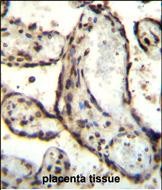HEXIM1 antibody (Center)
Affinity Purified Rabbit Polyclonal Antibody (Pab)
- SPECIFICATION
- CITATIONS
- PROTOCOLS
- BACKGROUND

Application
| WB, IHC-P, E |
|---|---|
| Primary Accession | O94992 |
| Other Accession | Q5M9G1, Q8R409, Q0X0C4, NP_006451.1 |
| Reactivity | Mouse |
| Predicted | Bovine, Rat |
| Host | Rabbit |
| Clonality | Polyclonal |
| Isotype | Rabbit IgG |
| Calculated MW | 40623 Da |
| Antigen Region | 194-222 aa |
| Gene ID | 10614 |
|---|---|
| Other Names | Protein HEXIM1, Cardiac lineage protein 1, Estrogen down-regulated gene 1 protein, Hexamethylene bis-acetamide-inducible protein 1, Menage a quatre protein 1, HEXIM1, CLP1, EDG1, HIS1, MAQ1 |
| Target/Specificity | This HEXIM1 antibody is generated from rabbits immunized with a KLH conjugated synthetic peptide between 194-222 amino acids from the Central region of human HEXIM1. |
| Dilution | WB~~1:1000 IHC-P~~1:10~50 E~~Use at an assay dependent concentration. |
| Format | Purified polyclonal antibody supplied in PBS with 0.09% (W/V) sodium azide. This antibody is purified through a protein A column, followed by peptide affinity purification. |
| Storage | Maintain refrigerated at 2-8°C for up to 2 weeks. For long term storage store at -20°C in small aliquots to prevent freeze-thaw cycles. |
| Precautions | HEXIM1 antibody (Center) is for research use only and not for use in diagnostic or therapeutic procedures. |
| Name | HEXIM1 |
|---|---|
| Synonyms | CLP1, EDG1, HIS1, MAQ1 |
| Function | Transcriptional regulator which functions as a general RNA polymerase II transcription inhibitor (PubMed:14580347, PubMed:15201869, PubMed:15713661). Core component of the 7SK RNP complex: in cooperation with 7SK snRNA sequesters P-TEFb in a large inactive 7SK snRNP complex preventing RNA polymerase II phosphorylation and subsequent transcriptional elongation (PubMed:12832472, PubMed:14580347, PubMed:15201869, PubMed:15713661). May also regulate NF-kappa-B, ESR1, NR3C1 and CIITA-dependent transcriptional activity (PubMed:15940264, PubMed:15941832, PubMed:17088550). Plays a role in the regulation of DNA virus-mediated innate immune response by assembling into the HDP-RNP complex, a complex that serves as a platform for IRF3 phosphorylation and subsequent innate immune response activation through the cGAS-STING pathway (PubMed:28712728). |
| Cellular Location | Nucleus. Cytoplasm. Note=Binds alpha-importin and is mostly nuclear (PubMed:16362050) |
| Tissue Location | Ubiquitously expressed with higher expression in placenta. HEXIM1 and HEXIM2 are differentially expressed. Expressed in endocrine tissues. |

Thousands of laboratories across the world have published research that depended on the performance of antibodies from Abcepta to advance their research. Check out links to articles that cite our products in major peer-reviewed journals, organized by research category.
info@abcepta.com, and receive a free "I Love Antibodies" mug.
Provided below are standard protocols that you may find useful for product applications.
Background
Expression of this gene is induced by hexamethylene-bis-acetamide in vascular smooth muscle cells. This gene has no introns.
References
Dow, E.C., et al. J. Cell. Physiol. 224(1):84-93(2010)
Ogba, N., et al. Oncogene 29(25):3639-3649(2010)
Schonichen, A., et al. Biochemistry 49(14):3083-3091(2010)
Czudnochowski, N., et al. J. Mol. Biol. 395(1):28-41(2010)
Krueger, B.J., et al. PLoS ONE 5 (8), E12335 (2010) :
If you have used an Abcepta product and would like to share how it has performed, please click on the "Submit Review" button and provide the requested information. Our staff will examine and post your review and contact you if needed.
If you have any additional inquiries please email technical services at tech@abcepta.com.














 Foundational characteristics of cancer include proliferation, angiogenesis, migration, evasion of apoptosis, and cellular immortality. Find key markers for these cellular processes and antibodies to detect them.
Foundational characteristics of cancer include proliferation, angiogenesis, migration, evasion of apoptosis, and cellular immortality. Find key markers for these cellular processes and antibodies to detect them. The SUMOplot™ Analysis Program predicts and scores sumoylation sites in your protein. SUMOylation is a post-translational modification involved in various cellular processes, such as nuclear-cytosolic transport, transcriptional regulation, apoptosis, protein stability, response to stress, and progression through the cell cycle.
The SUMOplot™ Analysis Program predicts and scores sumoylation sites in your protein. SUMOylation is a post-translational modification involved in various cellular processes, such as nuclear-cytosolic transport, transcriptional regulation, apoptosis, protein stability, response to stress, and progression through the cell cycle. The Autophagy Receptor Motif Plotter predicts and scores autophagy receptor binding sites in your protein. Identifying proteins connected to this pathway is critical to understanding the role of autophagy in physiological as well as pathological processes such as development, differentiation, neurodegenerative diseases, stress, infection, and cancer.
The Autophagy Receptor Motif Plotter predicts and scores autophagy receptor binding sites in your protein. Identifying proteins connected to this pathway is critical to understanding the role of autophagy in physiological as well as pathological processes such as development, differentiation, neurodegenerative diseases, stress, infection, and cancer.



